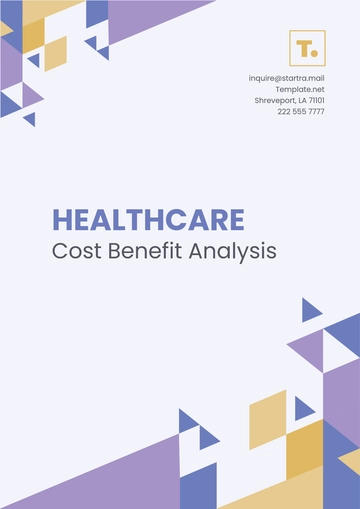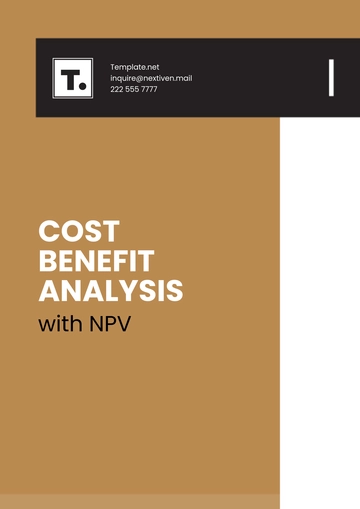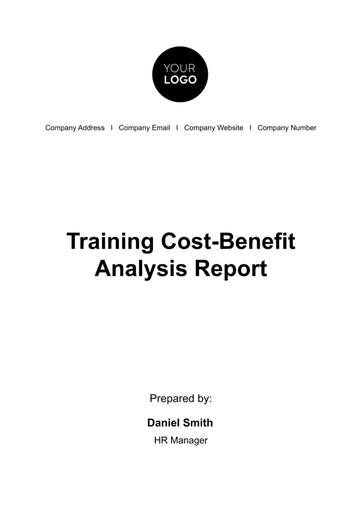Free Financial Compliance Cost Analysis

Prepared by | [Your Name] |
Date | [January 1, 2051] |
Executive Summary
This report provides a comprehensive analysis of the financial compliance costs incurred by [YOUR COMPANY NAME] during the fiscal year 2051. It encompasses both direct and indirect expenses related to maintaining compliance with federal, state, and industry-specific regulations. The purpose is to identify cost-effective strategies while ensuring adherence to regulatory standards.
Introduction
Financial compliance is critical for maintaining the integrity and reputation of [YOUR COMPANY NAME]. This report outlines the costs associated with compliance efforts, highlighting areas where efficiency can be improved without compromising regulatory standards.
Methodology
Data was collected from various departments, including Legal, Finance, and Operations. The analysis involves both quantitative financial data and qualitative insights from department heads.
Compliance Cost Breakdown:
Direct Costs:
Cost Category | Amount (in $ millions) | Description |
Legal Fees | [12.5] | Legal advisory and litigation costs |
Regulatory Fines and Penalties | [3.2] | Penalties for minor non-compliance incidents |
Compliance Software and Tools | [8.7] | Annual licenses and maintenance for compliance software |
Training and Education | [4.6] | Workshops, seminars, and online courses for staff |
Indirect Costs:
Cost Category | Amount (in $ millions) | Calculation Method |
Manpower | [15.3] | 30,600 hours at an average hourly rate of [$50] |
Opportunity Costs | [7.4] | Estimated revenue loss due to diverted resources |
Year-over-Year Comparison:
Financial Year 2050:
Cost Category | Amount (in $ millions) |
Total Direct Costs | [25.4] |
Total Indirect Costs | [19.7] |
Total Compliance Costs | [45.1] |
Financial Year 2051:
Cost Category | Amount (in $ millions) |
Total Direct Costs | [29.0] |
Total Indirect Costs | [22.7] |
Total Compliance Costs | [51.7] |
Year-over-Year Analysis:
Parameter | 2050 | 2051 | Change (%) |
Legal Fees | [10.8] | [12.5] | [+15.7%] |
Regulatory Fines and Penalties | [2.5] | [3.2] | [+28.0%] |
Compliance Software and Tools | [7.1] | [8.7] | [+22.5%] |
Training and Education | [3.9] | [4.6] | [+17.9%] |
Manpower Costs | [13.2] | [15.3] | [+15.9%] |
Opportunity Costs | [6.5] | [7.4] | [+13.8%] |
Total Compliance Costs | [45.1] | [51.7] | [+14.6%] |
Analysis Summary:
The overall compliance costs for [YOUR COMPANY NAME] increased by 14.6% from 2050 to 2051. The most significant increases were observed in regulatory fines and penalties, and compliance software tools, indicating the need for more stringent internal controls and possibly a review of current software solutions for efficiency improvements.
Cost-Benefit Analysis:
This section evaluates the return on investment (ROI) from compliance expenditures. The analysis considers risk mitigation benefits, penalty avoidance, and the impact on the company's reputation.
ROI Calculation:
Cost Category | Amount (in $ millions) | Benefits |
Legal Fees | [12.5] | Avoided [3] major litigations, potential savings of [$20 million] |
Regulatory Fines and Penalties | [3.2] | Avoided [5] major fines, potential savings of [$15 million] |
Compliance Software and Tools | [8.7] | Reduced manual hours by [2000] hours, equating to a saving of [$100,000] |
Training and Education | [4.6] | Increased employee compliance awareness, reducing future non-compliance risks |
Total Compliance Costs | [29.0] | Total Estimated Benefits (savings + avoided costs) of [$35.1 million] |
Benefit Assessment:
Risk Mitigation: Effective legal counsel and compliance tools have significantly reduced exposure to legal and regulatory risks.
Reputation Impact: Maintaining compliance has enhanced the company's reputation among investors and stakeholders.
Operational Efficiency: Investing in employee training has resulted in a more knowledgeable workforce, reducing future non-compliance incidents.
Recommendations:
Based on the analysis, the following strategic recommendations are proposed to optimize compliance costs:
Invest in Advanced Compliance Software:
Upgrade to more sophisticated compliance software that offers better automation and risk assessment tools.
Budget Allocation: [$10 million] for the next fiscal year.
Revise Internal Compliance Protocols:
Conduct a thorough review of current compliance procedures.
Develop a more streamlined approach to reduce man-hours and indirect costs.
Proposed Budget: [$2 million] for process improvement consultancy.
Enhanced Training Programs:
Introduce quarterly workshops focusing on emerging compliance trends and regulations.
Allocate additional funds for online training modules accessible to all employees.
Proposed Training Budget Increase: [20%], totaling [$5.5 million].
Negotiate with Legal Service Providers:
Explore opportunities to negotiate retainer fees or package deals with existing legal service providers to reduce costs.
Target Cost Reduction: [10%] in legal fees.
Regular Compliance Audits:
Implement semi-annual compliance audits to identify potential risks and areas for improvement.
Allocate [$1.5 million] for audit-related expenses.
Stakeholder Engagement:
Regularly update stakeholders on compliance strategies and performance, enhancing transparency and trust.
Allocate [$0.5 million] for stakeholder engagement initiatives.
- 100% Customizable, free editor
- Access 1 Million+ Templates, photo’s & graphics
- Download or share as a template
- Click and replace photos, graphics, text, backgrounds
- Resize, crop, AI write & more
- Access advanced editor
Assess the impact of compliance on your finances with Template.net's Financial Compliance Cost Analysis Template. This editable, customizable template evaluates the costs associated with meeting financial regulatory requirements. Essential for financial managers, it helps in budgeting for compliance activities, ensuring financial resources are effectively allocated to maintain regulatory adherence and fiscal health.





























